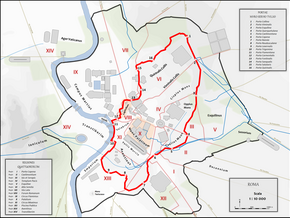Porte Naevia
| Porte Naevia | ||
 La porte Naevia sur une gravure de 1820 | ||
| Lieu de construction | Mur Servien, Aventin | |
|---|---|---|
| Date de construction | IVe siècle av. J.-C. | |
| Ordonné par | Sénat romain | |
| Type de bâtiment | Porte fortifiée | |
| Le plan de Rome ci-dessous est intemporel. |
||
| Coordonnées | 41° 52′ 44″ nord, 12° 29′ 15″ est | |
| Liste des monuments de la Rome antique | ||
| modifier |
||
La Porte Naevia (latin : Porta Naevia) est une des portes du mur servien, située entre la Porte Capène et la Porte Raudusculane à Rome.
Localisation
[modifier | modifier le code]D'après l'inscription de la « Base Capitoline », une inscription datée de 136 ap. J.-C. durant le règne d'Hadrien, la porte se situe dans la Regio XII. Une mention de Varron permet de situer plus précisément la porte sur l'Aventin mineur, près de la silva Naevia, entre les Tutilinae loca et la Porte Raudusculane[a 1],[a 2]. Ce site correspondrait aujourd'hui au passage entre les églises Santa Balbina et Santa Saba[1]. Le Vicus portae Naeviae qui franchit la porte devient la Via Ardeatina à l'extérieur du mur servien[2],[3].
Histoire
[modifier | modifier le code]Il s'agit d'une porte d'importance mineure. D'après Festus, la porte a reçu le nom de Naevia en souvenir de la Nemora Naevia qui a appartenu à un certain Naevius. Cet endroit avait mauvaise réputation à cause des nombreux vagabonds et débauchés qu'on pouvait y croiser[3],[a 3].
Notes et références
[modifier | modifier le code]- Sources modernes :
- Richardson 1992, p. 304.
- Platner et Ashby 1929, p. 410.
- Richardson 1992, p. 305.
- Sources antiques :
Bibliographie
[modifier | modifier le code]- (en) Samuel Ball Platner et Thomas Ashby, A topographical dictionary of Ancient Rome, Londres, Oxford University Press, , 608 p.
- (en) Lawrence Richardson, A New Topographical Dictionary of Ancient Rome, Baltimore, (Md.), Johns Hopkins University Press, , 488 p. (ISBN 0-8018-4300-6)
Article connexe
[modifier | modifier le code]Text is available under the CC BY-SA 4.0 license; additional terms may apply.
Images, videos and audio are available under their respective licenses.

